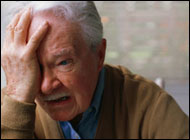Magnetic device may prevent migraine
A device that delivers magnetic pulses through the skull to the brain may become a migraine sufferer’s best friend, new research indicates.
Transcranial magnetic stimulation, or TMS as the technique is called, prevents or reduces the severity of migraines, according to preliminary studies reported Thursday at the annual meeting of the American Headache Society in Los Angeles.
“Migraine starts because of neuronal hyperexcitability, during which patients see flickering lights or other manifestations of an aura. The hyperexcitability phase is followed by fatigue and depression of neurons, which spreads throughout the brain, and the result is a pounding headache,” Dr. Yousef Mohammad said in a teleconference.
“We hypothesized that if we could interrupt this cortical spreading depression by administration of TMS, we could abort the headache,” he continued.
His group conducted a 3-month study that included eight migraine-with-aura patients. They were instructed to use a portable device, which they held to the back of their head to deliver two TMS pulses 30 seconds apart as soon as they experienced an aura. 
Mohammad, a neurologist at Ohio State University Medical Center in Columbus, told Reuters Health that the participants could continue using any preventive medication they might be taking but were barred from taking painkillers or triptan drugs for treating a migraine once one started.
The subjects experienced a total of 31 migraines during the study, and for 81 percent of these episodes the patients reported that they were headache-free within 2 hours of using the device.
They also rated their response to the treatment as very good or excellent for 55 percent of the attacks. In about three-quarters of the headaches, TMS eliminated nausea and sensitivity to noise and light.
Mohammad’s team went on to conduct a controlled trial with 42 migraine patients who were randomly to TMS treatment or inactive placebo treatment.
The TMS group had either no pain or only mild pain 2 hours after treatment in 69 percent of headache episodes, whereas the placebo group experienced similar relief for 48 percent of episodes.
Following TMS, work functioning was improved for 86 percent of headache episodes, versus 56 percent of the episodes in the placebo group.
“Our overall impression was that TMS was much better than placebo,” Mohammad said.
In neither of the studies were any adverse side effects tied to TMS.
Mohammad and his associates have begun a large, randomized clinical trial that will include patients with migraine with or without aura to validate these early findings.
Revision date: July 5, 2011
Last revised: by Jorge P. Ribeiro, MD